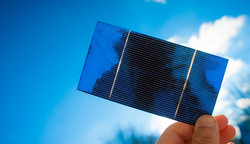Solar cells of unprecedented efficiency
To date, the fundamentals of operation of intermediate band solar cells have been demonstrated experimentally. The intermediate band allows for the absorption of low-energy photons that are otherwise transmitted through the photovoltaic material. Theoretical calculations have shown that efficiencies up to 63 % can be achieved under concentrated sunlight. The aim of the EU-funded project SIRACUSA (Study on intermediate band materials with prevailing radiative carrier recombination for superior solar energy applications) was to develop such a high-efficiency solar cell through the insertion of an additional band through deep impurities level. Researchers explored an alternative to the insertion of quantum dots in the intrinsic region of a p-i-n semiconductor. By means of molecular beam epitaxy, they created an intermediate band through the incorporation of a high concentration of iron (Fe) in gallium arsenide (GaAs), co-doped with silicon. Secondary ion mass spectrometry was used to characterise the new material and confirmed a high concentration of incorporated Fe. The electrical properties were studied based on Hall effect measurements. The presence of impurity-deep levels in the forbidden bandgap of a semiconductor has been traditionally considered detrimental to the performance of solar cells. However, theory predicts that, when incorporated at sufficiently high concentration, wave functions of foreign species overlap to form a band and suppress non-radiative processes. Before the SIRACUSA project, most practical implementations of the intermediate band concept were oriented towards the use of nanotechnology – in particular, quantum dots. These researchers were the first to attempt the manufacture of GaAs:Fe intermediate band solar cells. Photoresponse to photons with energy below the bandgap was speculated to arise mainly from As antisites and Ga vacancies. The introduction of additional energy states inside the bandgap by the Fe atoms also contributed to the generation of photocurrent. High photocurrent needs to be provided while maintaining the open circuit voltage of the solar cell. To this end, it will be necessary to exercise more rigorous control over the growth process in order to produce a high-quality cell material at low temperature. When trying to implement the intermediate band concept in practice, there are several materials and systems that have been theoretically proposed. Among the numerous candidates that are currently under study, the best choice may still be hidden among them.







